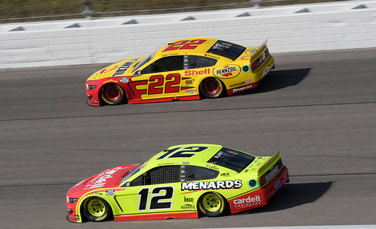Living the Life Cycle of a Cup Series Car
November 2, 2021
"Penske Material" provides an inside look at some of the personalities, stories and moments that make Team Penske so unique.
Back in 2013, NASCAR announced that the current generation of NASCAR race cars would be retired at the conclusion of the 2021 season. The Generation 6 car, also known as Gen-6, was designed to make the appearance of NASCAR stock cars more consistent with their street-legal counterparts, featuring individual chassis designed to reflect the showroom cars produced by series manufacturers Ford, Chevrolet and Toyota.
These high-performance Gen-6 machines were bulky, fast and tough to drive on track. The approximate weight of a Gen-6 machine, with a driver on board, is about 3,400 pounds. The cars include a steel tube frame chassis with an essential safety roll cage. Each part of these cars are highly engineered and they have undergone consistent and constant evaluation for performance and wear and tear.
In 2022, NASCAR’s new “Next Gen” cars will make their debut, featuring enhanced aerodynamic and downforce technology. As we enter the final days of NASCAR’s Gen-6 cars, let’s go under the hood to profile the life cycle of a Team Penske NASCAR Cup Series Ford Mustang.
For Gen-6 chassis, the life cycle is driven by engineering development as opposed to racing time or distance. Once improvements have been established to increase the performance of the car, the team will move as quickly as possible to get modifications approved, incorporated on the car and off to the racetrack. The process and pace executed by teams is geared towards making sure they take the equipment that is prepared to deliver the best possible results on track each week.
Teams have been able to use chassis for multiple races. Also, in some scenarios, Cup Series chassis may be transitioned for competition in the NASCAR Xfinity Series (NXS). Most of Team Penske’s Xfinity Series fleet were formally used as Cup Series chassis that were modified as needed to meet the specific NXS competition requirements.
For new car designs, Gen-6 chassis have been built out in sections. The front clip, rear clip and the center roll cage are then constructed, and within only a few days those individual components are joined together. Within a week, the interior sheet metal is applied to the car and internal quality control checks are completed. All new chassis must visit NASCAR’s Research and Development center for certification prior to competing on track, which can add a little time to the process.
Engines, gears and transmissions on the Gen-6 cars are similar in that they are considered “assemblies” that are made up of several other components. An engine block or transmission case may have a limit of 5,000 miles, but other internal components may only carry a 2,000-mileage limit. Transmissions, as an example, have a mileage limit of 5,000 before they become labeled as “Test Only.” However, the gear sets within each transmission has a limit of 4,000 miles before they are discarded or used only for testing. Engines follow the same basic formula, but the actual mileage numbers vary depending on the team’s engine manufacturer.
During a single Cup Series season, a team has been known to assemble approximately 170 cars. This total includes 152 primary cars complete with engines. The remaining cars serve as backups, which don’t include engines or a driveline. The number of backup cars can vary depending on the specific race, but four to five new cars can be assembled by teams each week for up to 40 events in a given season.
The Gen-6 Cup Series chassis are hung and installed new for each event and teams are capable of building a car, painting the chassis, and prepping that car for competition in just over two weeks. At that point the car is ready for the assembly group and final assembly typically takes three to five days. There are some variables that can affect the completion of the build including engine delivery delays, body work updates, arrival of new specification components, etc. All of these factors can affect how quickly a car is assembled and its deemed ready to go racing. The goal of the teams is to have a complete car ready to roll by the Tuesday before each race weekend.
Following a race, once a Team Penske car returns to the race shop from the track, the team’s assembly group will completely dismantle the machine down to its bare chassis. Once the Cup Series cars are fully disassembled, the chassis media is blasted back to bare metal. This process typically occurs on Mondays following a race, so that by Tuesday or Wednesday of any given week all of the individual components are inspected for wear and any other performance issues.
Then the life cycle begins again as cars are built fresh for the next race, incorporating build specifications designed for the unique characteristics of the specific track.
More Penske Material
Read more about the personalities, stories and moments that make Team Penske unique.





